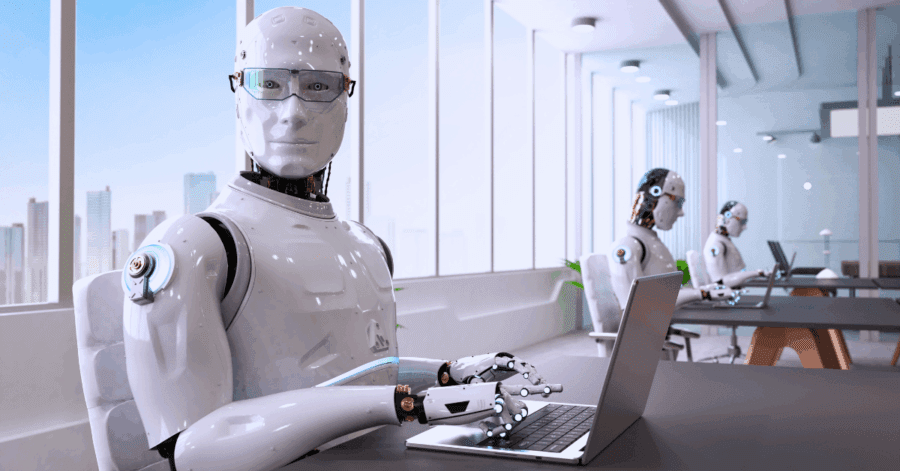
The dialogue surrounding AI often raises anxiety: Will I be automated out of a job? The fact is, things are far more optimistic; AI is not abolishing human potential but instead is fundamentally transforming it. For professionals in the job market seeking a career in AI, this transformation brings with it incredible opportunities to redefine what it means to work, leverage human strength with machine efficiency.
PwC’s AI Jobs Barometer (2025) cites evidence of this transition being driven by AI. The most AI-exposed industries report revenue growth per employee three times faster than less AI-exposed industries; salary growth rates are double that of other industries. Rather than driving away opportunities, AI is driving demand for new skills, new workflows, and entire categories of new AI jobs.
This is where the Superworker comes in, someone who will not compete with the machine but will work with the machine, using their human intelligence and strengths in all aspects of their work to redefine how they do their work.
Who exactly is a superworker?
A Superworker is neither a machine nor an AI tool. It’s a professional who taps into their human strengths of creativity, empathy, and adaptability while riding on AI’s speed and intelligence.
When it comes to Superworkers, it’s worth mentioning that Harvard research on “Superworkers” emphasizes that they are not just better employees but the future work leaders that are going to lead work in a way that fosters innovation in a collaborative environment where humans and machines, AI, can work together.
Simply put, a Superworker is not about working harder; a Superworker is about working smarter, using AI to expand your potential.
How AI is transforming work
- AI is not just about cost-efficient technology or speedier processes; the nature of the job is changing.
- The repetitive, mechanistic activities are now being directly managed by AI systems.
- The Human + AI combination:
- AI can analyze billions of data points in seconds.
- Employees are needed to build insights, ethical conclusions, and implement results into business directives.
- When combined with humans, AI doesn’t replace workers; it creates opportunities for more impact and relevancy.
- Organizations want employees to treat AI as a partner, allowing for collaboration instead of competition.
How companies are embracing superworkers
Forward-thinking organizations are actively fostering Superworkers. Instead of fearing job losses, they are redesigning roles around collaboration between humans and AI.
Many businesses are investing in AI training programs to help employees become AI-literate. Global certification bodies like the United States Artificial Intelligence Institute (USAII®), along with Ivy League institutions such as Harvard University’s AI Programs and MIT’s Artificial Intelligence: Implications for Business Strategy, are playing a key role here by offering structured learning and internationally recognized credentials.
These best AI certifications programs ensure professionals aren’t just passively using AI but actively leading projects with it. This shift is visible across industries, from finance to healthcare, where companies are prioritizing a hybrid model.
Superworker skills that matter
Becoming a superworker entails more than just knowing how to use an AI tool; it means developing a combination of both technical and human abilities:
Digital adaptability: New tools will always be adopted and embraced by those willing to adapt and use them; speed of change dictates the terms in every workplace.
Emotional intelligence: Machines can process information, but nothing will match a human’s ability to motivate others, empathize with others, and relate and connect with others.
Critical thinking: AI can provide you with data input; it is the human’s responsibility to ask the right questions, analyze the input, and determine the best paths forward.
AI learning: Understand how AI works and what it can and cannot do; this limits over-dependence or misuse.
How to become a superworker
The road to Superworker isn’t just for specialists; it is available to everyone open to change and looking to advance. Here are the steps:
Invest in lifelong learning
Stay curious and open to learning new skills and tools. By consistently upskilling, the potential learner is assured to keep their skills relevant in our fast-paced and ever-changing world.
Combine human and machine strengths
Use technology to handle the repetitive/routine and data-driven tasks so that your energy can be directed towards creativity, leadership, and complex problem-solving.
Co-create
Superworkers will thrive in environments where individuals openly co-create the ideas, perspectives, and solutions that they build together. Strength comes not from working alone, but from working collaboratively with others.
Growth mindset
Every new task or tool presents an opportunity to move forward and develop. Learning comes not from finding the perfect rendition but rather from keeping consistent movement forward, while also learning the process along the way.
Why superworkers are the future
The future of work is not “humans vs. machines.” The future will belong to us all, especially those who choose to collaborate. Superworkers are proving that AI doesn’t devalue humanity; it enhances it.
As companies focus more on efficiency, creativity, and resilience, the need for Superworkers will rise. Those with AI literacy, emotional intelligence, and adaptability will not react to change; they will lead it.
Conclusion
AI is not a threat; it is, however, an amplifier. The superworker succeeds by engaging technical AI skills and learning continuously, along with uniquely human attributes such as empathy, creativity, and decisiveness. By leveraging AI as a partner, professionals will innovate more quickly, make more informed decisions, address complex problems, and deliver greater value. The future belongs to those who are open to evolving their understanding of work, adapting how they work, and leading with empathy and the efficiency of AI.

